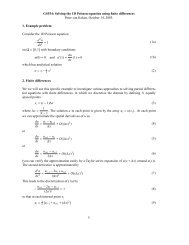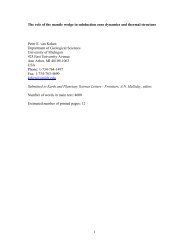ARTICLE IN PRESS 24 N.D. Sheldon, N.J. Tabor / Earth-Science Reviews xxx (2009) xxx–xxx Fig. 14. (A) Cross plot of 10 3 ln 18 α values versus temperature (°C) for common pedogenic minerals. 0 °C is shown as the lower limit, because it assumed that liquid water is required for chemical reaction <strong>and</strong> formation of pedogenic minerals. Thin black vertical line at 30 °C is the approximate upper limit of soil temperatures based on mean annual surface air temperatures from weather stations in the International Atomic Energy Association (IAEA) global network for isotopes in precipitation database (Rozanski et al., 1993). Arabic numbers within graph indicate studies which reported the 10 3 ln 18 α value: 1=calcite, Kim <strong>and</strong> O'Neil (1997); 2=calcite, O'Neil et al. (1969); 3= goethite, Yapp (1990); 4=geothite, Bao <strong>and</strong> Koch (1999); 5=goethite, Muller (1995); 6=hematite @ pH=1–2, Yapp (1990); 7=hematite, Clayton <strong>and</strong> Epstein (1961); 8=hematite @ pH =1–2, Bao <strong>and</strong> Koch (1999); 9=hematite @ pH =8–9, Bao <strong>and</strong> Koch (1999); 10=Gibbsite, Bird et al. (1994a); 11=boehmite, Bird et al. (1992); 12=Kaolinite, Sheppard <strong>and</strong> Gilg (1996); 13=smectite, Delgado <strong>and</strong> Reyes (1996); 14=siderite, Carothers et al. (1988). See Text for discussion. (B) Cross plot of 10 3 ln D α values versus temperature (°C) for common hydroxylated pedogenic minerals. See text for discussion. (C) Cross plot of 10 3 ln 13 α values versus temperature (°C) for common pedogenic minerals. See text for discussion. vary with temperature, although goethite 10 3 ln D α values do vary according to Al substitution for Fe in the crystal lattice (Feng <strong>and</strong> Yapp, 2008). Phyllosilicates exhibit temperature dependence, where 10 3 ln D α values decrease with higher temperatures (Fig. 14B). In addition, 2:1 phyllosilicate10 3 ln D α values vary according the concentration of octahedrally-coordinated metal cations, where 10 3 ln D α=− 2.2⁎10 6 / T 2 −7.7 + (2 ⁎Al−4⁎Mg−68⁎Fe) (Suzuoki <strong>and</strong> Epstein, 1976; Gilg <strong>and</strong> Sheppard,1996; Tabor <strong>and</strong> Montañez, 2005). This effect could result in isothermal 10 3 ln D α smectite-H2O values that differ by ~70‰, although Tabor <strong>and</strong> Montañez (2005) found that the chemistry among 14 different Permian–Pennsylvanian paleosol smectites accounted for isothermal 10 3 ln D α smectite-H2O variability no greater than ~5‰. Please cite this article as: Sheldon, N.D., Tabor, N.J., <strong>Quantitative</strong> <strong>paleoenvironmental</strong> <strong>and</strong> <strong>paleoclimatic</strong> <strong>reconstruction</strong> using paleosols, Earth- Science Reviews (2009), doi:10.1016/j.earscirev.2009.03.004
ARTICLE IN PRESS N.D. Sheldon, N.J. Tabor / Earth-Science Reviews xxx (2009) xxx–xxx 25 Mineral-CO 2 carbon isotope fractionation values (10 3 ln 13 α; Table 5; Fig. 21) forcalcite(Bottinga, 1968) <strong>and</strong>theFe(CO 3 )OH group in solid solution with goethite (Yapp <strong>and</strong> Poths,1993) are positive, indicating that 13 C is enriched in the mineral product, whereas mineral-bound C that is apparently in solid solution with gibbsite (Tabor <strong>and</strong> Yapp, 2005a,b) shows no fractionation with respect to gaseous CO 2 (i.e., gibbsite <strong>and</strong> CO 2 δ 13 C values are equivalent; Schroeder <strong>and</strong> Melear, 1999). Calcite-CO 2 10 3 ln 13 α values decrease with increasing temperature (Fig. 14A), whereas goethite-CO 2 <strong>and</strong> gibbsite-CO 2 10 3 ln 13 α values do not exhibit temperature dependence (Yapp, 2001a,b). Although siderite-CO 2 10 3 ln 13 α values appear to follow closely those for calcite-CO 2 , siderite- CO 2 10 3 ln 13 α values are too poorly studied at this time to be expressed as a temperature-dependent fractionation equation (see Fig. 14C). 7.1.3. Relationship between hydrogen <strong>and</strong> oxygen isotopes in continental waters The vast majority of continental surface waters are meteoric in origin (Dansgaard, 1964; Gat <strong>and</strong> Bowser, 1991). That is, surface waters are derived from the atmosphere as precipitation (rainfall <strong>and</strong> snow). The main source of meteoric water is vapor derived from evaporation of ocean water, which has maintained mean δ 18 O values near 0‰ (±2‰) for most of the Phanerozoic (Gregory, 1991; Yapp <strong>and</strong> Poths, 1992; Tabor, 2007; Eiler, 2007). Over the continents, the oxygen <strong>and</strong> hydrogen isotope values of rainfall follow a Rayleigh-type distillation, whereby subsequent rain-out events have progressively more negative oxygen <strong>and</strong> hydrogen isotope values. The rain-out process is driven principally by cooling of the air-mass (Dansgaard, 1964; Fig. 15), which may arise from vertical thermal uplift, physical transport over high-altitude sites (e.g., mountains), or latitudinal transport to cooler sites (e.g., Rozanski et al., 1993; Clark <strong>and</strong> Fritz, 1997). The oxygen <strong>and</strong> hydrogen isotope values of rainfall are strongly correlated, <strong>and</strong> may be approximated by the equation for the meteoric water line (Craig, 1961): δD=8⁎δ 18 O+10. While there is abundant evidence for short-term departures from the meteoric water line (e.g., Gat <strong>and</strong> Bowser, 1991; Krishnamurthy <strong>and</strong> Bhattacharya, 1991; Lawrence <strong>and</strong> White, 1991), the long-term weighted mean of precipitation δ 18 O <strong>and</strong> δD values indicates that the aforementioned equation for meteoric water is an accurate representation of isotopes in the meteoric water cycle. Considering that timescales for significant accumulation of authigenic minerals in soil profiles range from 10 3 – 10 5 years, it is generally assumed that Craig's (1961) meteoric water line equation is an accurate representation of precipitation that rained upon, <strong>and</strong> percolated through, the soil profile (e.g., Yapp, 1993a, 2001a,b; Delgado <strong>and</strong> Reyes, 1996; Ferguson et al., 1999; Savin <strong>and</strong> Hsieh, 1998; Vitali et al., 2001; Tabor <strong>and</strong> Montañez, 2002, 2005; Tabor et al., 2002; Tabor, 2007; Gilg, 2003). In fact, both the δ 18 O<strong>and</strong>δD values of rainfall are correlated with surface air temperature (e.g., Fig. 15 — IAEA Database from Rozanski et al., 1993). Based upon previous studies of meteoric precipitation δ 18 O <strong>and</strong> δD values, Criss (1999; see also Dansgaard, 1964) arrived at the following correlation: δ 18 O MAP ≈0.695 MAT(°C) — 13.6, where MAP is the weighted mean annual precipitation <strong>and</strong> MAT is the mean annual surface atmospheric temperature. This general correlation indicates that precipitation δ 18 O values will decrease by ~0.7‰ with each °C fall in temperature. Given the relation between altitude, latitude, <strong>and</strong> temperature, Criss (1999) also presented empirical relationships between precipitation δ 18 O values <strong>and</strong> altitude, Δδ 18 O≈2±1‰ km −1 ,aswellas latitude, Δδ 18 O≈0.2±0.1‰ 100 km − 1 . Criss (1999) emphasizes, however, that these relationships are only rough approximations, <strong>and</strong> as will be discussed in subsequent sections, application of these observed relations to the isotope composition of paleosol minerals (paleosol calcite, for example) as a means of <strong>paleoclimatic</strong> <strong>reconstruction</strong> should be avoided or used with extreme caution. 7.2. Carbon in soils The δ 13 C value of pedogenic minerals may be directly related to the δ 13 C value of CO 2 in the local soil environment (Cerling, 1984; Quade et al., 1989; Schroeder <strong>and</strong> Melear, 1999; Schroeder et al., 2006). However, soils may be characterized by mixing of one, two, or three components of soil CO 2 , which can result in significantly different δ 13 C values of soil CO 2 <strong>and</strong> the resulting soil mineral. The three CO 2 components are derived from (1) oxidation of in situ organic matter, (2) tropospheric CO 2 , <strong>and</strong> (3) dissolution of pre-existing carbon-bearing minerals such as carbonate in the soil (Yapp, 2001a,b, 2002). Based upon geological <strong>and</strong> chemical arguments, the conditions of soil CO 2 mixing in the paleosol at the time of mineral crystallization must be assessed in order to interpret appropriately the environmental significance of mineral δ 13 C values (e.g., Quade et al., 1989; Hsieh <strong>and</strong> Yapp, 1999; Tabor et al., 2004a,b; Tabor <strong>and</strong> Yapp 2005b; Tabor et al., 2007), <strong>and</strong> to determine whether the minerals formed in the presence of one, two, or three components of soil CO 2 . 7.2.1. One-component soil CO 2 In a strict sense, soils with only one component of CO 2 form under a chemically closed-system, but it is also useful to include in this category soils which form under semi-closed systems (e.g., Gluyas, 1984; Tabor et al., 2007). Chemically closed or semi-closed conditions arise in settings where gaseous diffusion between the soil <strong>and</strong> the troposphere is limited, usually as a result of poorly drained, waterlogged conditions within the soil profile. Diffusion from the troposphere (including CO 2 ) to the soil is limited, <strong>and</strong> aqueous O 2 in the soil is quickly consumed by oxidation of organic matter (Feng <strong>and</strong> Hsieh, 1998). Yet, oxidized carbon species (CO 2(aq) , HCO 3 − ,CO 3 2− ) may still be liberated from closed system soils at pH levels permissive of carbonate precipitation (~pH=5.5–8.5; Irwin et al., 1977; Gluyas, 1984) in the following types of reactions: SO 2− 4 þ 2CH 2 O→H 2 S þ 2HCO − 3 ð48Þ SO 2− 4 þ 2CH 2 O→HCO − 3 þ HS − þ H 2 O þ CO 2 : ð49Þ Fig. 15. Cross plot of weighted mean annual δ 18 O values versus mean annual surface air temperature for 209 weather stations from the International Atomic Energy Association (IAEA) global network for isotopes in precipitation database (Rozanski et al., 1993). The points upon the polygon that surround data points above 0 °C are used to construct a modern surface domain for hydroxylated minerals. See text for discussion. Under these conditions, both bicarbonate <strong>and</strong> resulting carbonbearing minerals will have δ 13 C values that are equivalent to that of the oxidizing organic matter in the closed-system soil. For example, given that C 3 plant organic matter has δ 13 C values ranging from approximately − 20 to − 33‰ (mean=− 27‰; see Section 7.6), carbon-bearingmineral δ 13 C values in a closed system soil profile will have δ 13 C values ranging from − 20 to − 33‰. Soilprofiles forming under semi-closed conditions will result in more positive calcite δ 13 C values (because Please cite this article as: Sheldon, N.D., Tabor, N.J., <strong>Quantitative</strong> <strong>paleoenvironmental</strong> <strong>and</strong> <strong>paleoclimatic</strong> <strong>reconstruction</strong> using paleosols, Earth- Science Reviews (2009), doi:10.1016/j.earscirev.2009.03.004
- Page 1 and 2: EARTH-01563; No of Pages 52 ARTICLE
- Page 3 and 4: ARTICLE IN PRESS N.D. Sheldon, N.J.
- Page 5 and 6: ARTICLE IN PRESS N.D. Sheldon, N.J.
- Page 7 and 8: ARTICLE IN PRESS N.D. Sheldon, N.J.
- Page 9 and 10: ARTICLE IN PRESS N.D. Sheldon, N.J.
- Page 11 and 12: ARTICLE IN PRESS N.D. Sheldon, N.J.
- Page 13 and 14: ARTICLE IN PRESS N.D. Sheldon, N.J.
- Page 15 and 16: ARTICLE IN PRESS N.D. Sheldon, N.J.
- Page 17 and 18: ARTICLE IN PRESS N.D. Sheldon, N.J.
- Page 19 and 20: ARTICLE IN PRESS N.D. Sheldon, N.J.
- Page 21 and 22: ARTICLE IN PRESS N.D. Sheldon, N.J.
- Page 23: ARTICLE IN PRESS N.D. Sheldon, N.J.
- Page 27 and 28: ARTICLE IN PRESS N.D. Sheldon, N.J.
- Page 29 and 30: ARTICLE IN PRESS N.D. Sheldon, N.J.
- Page 31 and 32: ARTICLE IN PRESS N.D. Sheldon, N.J.
- Page 33 and 34: ARTICLE IN PRESS N.D. Sheldon, N.J.
- Page 35 and 36: ARTICLE IN PRESS N.D. Sheldon, N.J.
- Page 37 and 38: ARTICLE IN PRESS N.D. Sheldon, N.J.
- Page 39 and 40: ARTICLE IN PRESS N.D. Sheldon, N.J.
- Page 41 and 42: ARTICLE IN PRESS N.D. Sheldon, N.J.
- Page 43 and 44: ARTICLE IN PRESS N.D. Sheldon, N.J.
- Page 45 and 46: ARTICLE IN PRESS N.D. Sheldon, N.J.
- Page 47 and 48: ARTICLE IN PRESS N.D. Sheldon, N.J.
- Page 49 and 50: ARTICLE IN PRESS N.D. Sheldon, N.J.
- Page 51 and 52: ARTICLE IN PRESS N.D. Sheldon, N.J.















